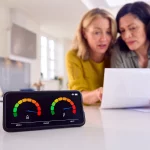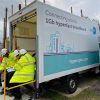Report Claims Labelling Could Help UK Uptake of FTTP Broadband

A new report from WIK-Consult, which was commissioned by CityFibre, has claimed that the introduction of a new UK labelling system, with better information on broadband services, could increase consumer take-up of gigabit Fibre-to-the-Premises (FTTP) ISP products by 40% (i.e. an extra 1.6 million homes by 2025).
Growing take-up by consumers is important to the new generation of “full fibre” providers because it helps to prove their business models to investors (most such operators like to get at least 20-25% take-up). In keeping with that, it gives a useful idea of how long a provider may have to wait until seeing some payback on their investment (FTTP is expensive to deploy and so it could be many years before that investment is returned).
Last year’s preliminary report from the new Gigabit Take-Up Advisory Group (GigaTAG) proposed, among other things, that one way to improve take-up of full fibre services in the UK might be to introduce a “labelling system for broadband packages to provide simple, clear and consistent information.”
Advertisement
Some countries, like Italy, already have something similar where FTTP is given a circular green label, while yellow denotes slower hybrid fibre (FTTC), and pure copper (ADSL) broadband lines (or slow speed wireless services) get a nasty red colour.
One complication here might be Virgin Media’s Hybrid Fibre Coax (HFC DOCSIS 3.1) network, which can deliver multi-gigabit download speeds (not to mention FTTB deployments to MDUs), which would require some extra consideration. Likewise, it is possible, under the right circumstances and setup, for some fixed wireless networks, and even 5G mobile, to achieve 1Gbps+ speeds.
The labelling idea also plays into CityFibre’s long fight against potentially misleading use of terminology like “fibre broadband” in advertising (i.e. using it for both FTTP and slower FTTC services etc.). The Advertising Standards Authority (ASA) has been highly successful at rebuffing their challenges (example), but the enforcement of a new labelling system might be one way to get around that particular roadblock.
The WIK-Consult Report
The findings of the new report are based on a consumer survey and a conjoint study involving a representative sample of 3,000 UK consumers, each of whom spent around 15 minutes answering questions and choosing from amongst hypothetical broadband offers. The fieldwork was conducted by YouGov, although the survey itself was designed and the results analysed by WIK-Consult.
Advertisement
In regard to consumer confusion, the study found that almost half of consumers claim not to know what ‘superfast’, ‘ultrafast’ and ‘gigabit’ mean. Respondents who did provide their understanding of what these terms mean tended to significantly overestimate the speeds offered by ‘superfast’ and ‘ultrafast’ connections (e.g. respondents on average claimed that ‘superfast’ equates to a speed of 500Mbps, when Ofcom in fact define it as speeds of 30Mbps or better). Many consumers also do not know whether they genuinely have full fibre.
Overall, the results of the survey and conjoint analysis reveal a high degree of confusion amongst consumers, which may translate into reduced take-up of full fibre, and a loss in consumer welfare as consumers face challenges in making choices which reflect their true preferences. This is where the labelling system gets proposed as a solution.
We note that the simplified label design proposed in the conjoint study appears to be similar to those Energy Performance Certificates (EPCs) that you often see on houses and electrical devices, with bars of decreasing size (labels going from A to D). The idea being that gigabit style full fibre services would get an A, while slow ADSL copper lines might get a D etc.

Advertisement
The study found that the introduction of a label together with an information campaign has a “substantial positive impact” on the take-up of full fibre, with take-up increasing by approximately 40%, and seems effective at promoting take-up of full fibre across all UK broadband consumers (i.e. would support purchasing decisions across all different demographics of broadband consumers).
Finally, 61% of participants to the study considered that the label presented was informative and helped them when making purchasing decisions. For those who had the information treatment to explain more about the label, the impact was greater, with 68% claiming it helped inform their decisions.
Greg Mesch, CEO at CityFibre, said:
“The huge potential for broadband labelling to improve awareness, trust and take-up of Full Fibre is great news for consumers and for the country. With nationwide rollout ramping up fast, Full Fibre will soon be within easy reach of most homes and businesses. Now is the time to focus on helping them to switch, so we can unleash the economic benefits of Full Fibre as quickly as possible and bolster the investor confidence needed to complete the nationwide rollout.”
At this stage we don’t know what direction GigaTAG will take on all this and at the end of the day it can only advise the Government on what course to adopt, but a wider industry consultation may be required before introducing any such changes. GigaTAG’s final set of recommendations to Government are expected this May 2021.
Meanwhile, we can’t help but feel that it might just be simpler to focus on ensuring that all ISPs promote the required average download and upload speeds (a median as measured at peak time) on their products. At present some ISPs continue to hide their slower upload rates and some smaller providers are still showing maximum speeds, rather than the peak time average. Suffice to say there’s room for improvement all round.
On the other hand, we might not even need to be considering a labelling system if it wasn’t for the ASA’s dogged instance that calling slower hybrid services “fibre broadband” is all fine and dandy. Lest we also forget that, for most people, just being able to access a gigabit-capable broadband network is the first hurdle that still really needs to be crossed (at present this covers c.40% of UK premises).
Mark is a professional technology writer, IT consultant and computer engineer from Dorset (England), he also founded ISPreview in 1999 and enjoys analysing the latest telecoms and broadband developments. Find me on X (Twitter), Mastodon, Facebook, BlueSky, Threads.net and Linkedin.
« CEO of the Government’s Building Digital UK Team to Leave UPDATE2
SSE Enterprise Telecoms UK Rebrands to Neos Networks »























































A clear labelling system is long over due, as I believe the use of ‘Superfast’ in some branded material misleads and creates confusion among customers.
How can anyone be confused Charlie? I’ve got super deluxe ultra mega fast fibre over a shiny copper cable.
I’m not technical enough to know the fine details but some pretty graphics tell me it’s good, so it must be good.
lol
Doesn’t help that most customers think they already have fibre because of BT and Virgin’s marketing
100% no one wanted to join a project community fibre project that would have been almost free due to the voucher scheme for rural locations, they all think they have fibre and superfast. We get 18-20 Mbps and honestly probably don’t understand the reason the internet is slow when they already have “superfast”
ISPs need to change the wording desperately and then write to existing customers saying they are on the “legacy or standard” network.
As long industry keep using the word ‘fast’ ‘giga’ ‘hyper’ rather than describing ‘throughput’ and the properties of what is a shared best efforts data transport service during the busy hour then customers will continue to be misled.
Agree entirely including Upto and average
It also needs to reflect the ISP service not the theoretical connection speed and in my view should state the guaranteed speed range.
Industry does both, through a combination of bespoke speed estimate ranges taken at peak network loading time and speed ranges on non-rate adaptive services.
https://www.virginmedia.com/shop/broadband/speeds as an example.
What did you have in mind and how would you measure it? To what from where?
@CarlT These averages cover the access speed which is great. Some of the planning rules need to be exposed. Peak hour bandwidth per customer is crucial to set a minimum service level. Reference networks should be modelled so the packet loss, jitter and delay is available and published. The latter can be translated into – numbers of zooms calls, or streaming supported in the busy hours.
The pandemic has proven that those who have access to NGA can home work from 97% (98%+ contracted) premises so there no reason not to do this as it has to already exist in some form. Peak hour bandwidth drives much of the cost so this should be shared. The standards bodies have done a very good on this matter, most not appreciated.
A very few minutes of thoughts:
‘Peak hour bandwidth per customer is crucial to set a minimum service level’
Doesn’t matter. The network never saturates it’s not an issue. Is also not a great guide due to many factors that non-network engineers shouldn’t be expected to understand. Bandwidth between what and what?
‘Reference networks should be modelled so the packet loss, jitter and delay is available and published.’
There’s no reference customer or network. This can only be done on the ISP’s internal network between set points so won’t be representative of customer Internet experience.
‘The latter can be translated into – numbers of zooms calls, or streaming supported in the busy hours.’
The busy hours for Zoom and streaming are different. Streaming is dependent on bandwidth, Zoom is more sensitive. Zoom and streaming can have vastly different requirements depending on a variety of factors. To standardise a number would again require something a long way from a representative value of customer experience.
‘The pandemic has proven that those who have access to NGA can home work from 97% (98%+ contracted) premises so there no reason not to do this as it has to already exist in some form. Peak hour bandwidth drives much of the cost so this should be shared.’
The peak hours for home working are daytime. The peak for overall usage is the evenings. Upstream usage is highest during the day. With the exception of Virgin Media and upstream load WFH is using capacity that’s already there.
If you want end to end bandwidth you’re asking for a figure that’ll strike people as absurdly low and be utterly meaningless, not to mention impossible to calculate.
You should ask capacity planning and network engineering people about this one before calling for something that would turn a one-page ad into a thesis. You’re expecting ISPs to provide information on £20/month broadband lines they don’t, and can’t, provide on £1000s per month DIA.
As soon as data leaves an ISP’s network they are no longer in control of it. As soon as you demand an actual minimum capacity, rather than an apparent and practical minimum, things get really complicated.
The best that can reasonably be done is performance between customer sites based on either being 100% on-net or via SLAs provided by third parties that run networks. That and SamKnows numbers which are useful to an extent but for these purposes aren’t helpful.
The labelling is something that crops up every now and then and then someone always pops up wanting to add a few things and as you say it ends up being a page of lots of figures which simply confuse people and once again the best sales pitch wins rather than the best technical option.
Nothing stopping CityFibre mandating to its ISP using the network to adopt a standardised label.
Carl – I once had a customer complain about packet loss about 5 hops and 2 ASN outside our network, not even an AS we were peering with.
They didn’t really seem to grasp that we have no influence on what goes on outside our network, and that we have no authority to demand they fix anything.
I thought of a really good way to demonstrate the issues with this data-obsessed approach.
https://www.thinkbroadband.com/broadband/monitoring/quality/share/d3e4b9ab911983521ce0b5421eace6b9286023e5-31-03-2021
https://www.thinkbroadband.com/broadband/monitoring/quality/share/216373a77bd3f7b2d17faf63c6d599318aea5ac6-31-03-2021
Pretty different, right?
One of those is the service on port 2 of my ONT, the other the service on port 3.
Jitter on both is basically nil. Latency is within a couple of milliseconds to most of the Internet.
One of them has peering to TBB’s host, NCUK, the other doesn’t, yet.
Both ISPs deliver line rate 24×7 with zero signs of congestion, zero degradation, there’s that discrepancy in routing that means latency is variable on a path.
While model networks, etc, etc, sound great the real world isn’t good enough to fit into such a convenient box. Access network performance is about the best that can be done.
Even using the same application it’s not like Zoom is a single server. Even where servers resolve to the same IP it’s perfectly possible to be connecting to many different devices depending which ISP you’re on thanks to anycasting – https://en.wikipedia.org/wiki/Anycast
If it was just the one you lived a blessed existence, Ferrocene. A previous employer had a professional gamer threatening to take us to court for loss of earnings over performance of devices outside of our network.
We ended up prepending the prefixes from one provider and using another to save the grief.
Carl, there was also a customer who couldn’t see why by default we’d prefer a route they sent directly over to us vs. an indirect route via the customer’s other provider.
I can completely understand them being a bit confused about why their prepending was doing nothing, but their confusion AFTER I explained why did cause me to stare at the wall for a bit in thought. On the plus side, they did listen and tag their routes with the desired community so all in all I guess that’s a win.
Would have been good to see your customer laughed out of court and hit with hefty legal costs but sadly I know all too well sometimes it isn’t worth the hassle.
Keeps us in a job at least!
It was a line in a route map. Traffic was minimal as gaming so really wasn’t worth the effort 🙂
@CarlT
I appreciate that buried in the relevant ISPs site there will be service definitions but these are not always clearly stated on their order sites, present but not prominent or absent, particularly comparison sites.
Labelling/logos are clearly not going to change that but anything that highlights to the consumer when comparing products or when the ISP fails to meet the minimum what they are entitled to has to be of benefit whether its WISP, FTTC, HFC or FTTP.
We already have a bunch of providers selling products with guaranteed speeds?
https://www.ofcom.org.uk/phones-telecoms-and-internet/advice-for-consumers/advice/broadband-speeds-code-practice
A good suggestion.
Having the nerve to call something “fibre” that’s delivered by a copper TV wire (or tin cans and string in the case of openreach), is pushing it.
With the rise in competitors that use real fibre, it’s totally unfair to allow copper networks to be advertised as fibre networks.
Totally agree!
So how are data packets delivered over HFC inferior to those delivered va FTTP at any given data rate and latency? It’s performance that matters.
Docsis is totally inferior to FTTP at any given data rate and latency (docsis is overall less packet reliability and latency vs VDSL even ADSL at times)
Soon as FTTP comes to my area I drop virgin right away ( only reason I’m staying with Virgin right now it’s because I can only get 20mb on VDSL)
Winston, HFC is absolutely inferior due to both the way the network is built and the DOCSIS standard. A standard FTTP build will be superior to VM using RFoG, and for the parts of the network that are HFC it utterly destroys it when it comes to latency and reliability.
This applies even in areas where VM have provisioned well – I have a connection with VM that a lot of users would probably kill for given how bad some areas are… and I still got better latency on FTTC.
My FTTP connection gets switched on next week, and that will be the end of my relationship with Virgin Media. I literally put the order in the day Openreach made the area live.
It is the performance that matters… and it’s no contest.
Fiber city need real sellers as voda no signal phone are just as scammy as very meaner are
So if they want to get seen more use real company to sell its service not con jobs like VP are and VM are
Fiber city a have good true fiber network but got into bed with second to worst company ISP
Technically they could have 3 categories…
FTTE (Fiber to the Exchange)
FTTC
FTTP
BT’has shot themselves in the foot with their idiotic decision to market fttc as “fibre” which is clearly isn’t any more than adsl from the exchange is.
The number of technically illiterate who’ve told be “we already have fibre” boggles the mind but explains low takeup in a nutshell.
Add to the fact that openreach took public money for a pointless fttc roll out to monetise their copper network for another few years amounts to a public subsidy of old technology that should never have been allowed to happen.
The Uk should have been going straight to fibre 10 years ago, instead billions have been squandered on already redundant technology, add to that the waste of the planets resources for all those street cabinets and their contents I’m amazed that this is not a major scandal.
Tell those who moved from sub-2Mb ADSL to FTTC 5+ years sooner than FTTP would’ve reached them it was pointless.
I understand why they push A as the best available and they are picking up from household appliances as their lead, but it would make more sense if they could reverse it. That way in future years you can simply go down the alphabet and add more letters as speed options become viable and no need to adjust previous incarnations.
This way we will undoubtedly end up with what happened to the EPCs with entries like ‘A+++++++’
It is also a shame that they couldn’t come up with a suggestion that highlighted the symmetry of the connection in an easy to use graphic – they seem to have just plumped for a copycat version of EPCs.
CarlT – I have worked with network performance engineers. The Broadband Forum has got some very good proposals on this matter.
Services cannot be random, capacity at various points will have planning rules if the services are to function.
Services aren’t random but ISPs don’t plan links based on the total size of the customer base. They base them on usage forecasts.
I can’t see anything on that website that’d do what you want to it.
It’s academic anyway. Won’t be happening. Can’t be done reliably. No demand for it.
Access line performance only, never ever what the very lowest possible speed may be as can’t guarantee anything.
Again guarantee between what and what? Sam knows will have to do.
Last year my neighbour bought FTTC from Sky. He assumed it was full fibre and was surprised to find out it was still coming over the copper lines. I’m not sure what speed he actually got. I just know my speed dropped when he signed up.
After 6 months he dropped Sky and signed up for VM. He’s been with them ever since.
I have a cousin that has FTTP available to his house but didn’t know until I informed him.
FTTP gets a raw deal in advertising.
“ASA’s dogged instance that calling slower hybrid services “fibre broadband” ”
I think that’s one of the main reasons so much confusion was created unnecessarily in the backwards country.
Also, does this proposed labeling system take upload speeds into account, too? If not, then it will be pretty useless anyway. Symmetric fibre broadband is superior to Openreach’s asymmetric FTTP or FTTC.
Waste of time, money and wouldn’t work.
Broadband performance varies between providers as shown above,
Grading packages and providers could be an idea but we’ve been trying to do that for years and it don’t work.
If they want to change the advertising standards then that should of happened years ago, again also mentioned, selling FTTC as fibre broadband is b***ox, even selling it as Superfast can be misleading though acceptable.
FTTC lines vary from 128kb/s – 350mb/s (includes G.fast) so grading addresses as fast or superfast or gigabit would be ideal but again its just marketing spiel and just a push to get people actively looking at new services when nothing new has happened other than a sales pitch.
You could have a fourth option
How about this, like in Europe they have FTTR – Fibre To The Router,
so the Fibre runs past the Front/Back Door and into the Router
My cousin in Portugal has it and he says it is very very fast and trouble free
That’s FTTP.
Mine would really cook your noodle. Fibre – copper x 3 – fibre – copper x 3 – router.
Doesn’t harm any performance.
This will fix itself at some point as BT will stop marketing FTTC and GFast as fibre when they need to up sell to FTTP.
I would guess around the 40% penetration mark?
It will be another UK rip off?costing twice as much as other countries, N/Z as had this for 10 years and at half the price we will have to pay!and its going to be the same with E/cars that’s why the UK as to wait for everything!its called fat cat Greed ,we are being left behind because that’s how the UK works!the British public put up with what ever the government throws at them,and when they are done they just clear off abroad with a big fat pension?
The government (And the ASA and ofcom) have supported misleading terms such as “fiber broadband” and “super fast” for a significant period of time.
I asked my neighbours if any of then wanted to join an openreach community fibre partnership, explained due to our location we might be elegible for government vouchers.
One said “I’m already on superfast broadband” and the other said “i already have fibre”. At this point I gave up and instead bought a second broadband line for our property.
We all have 18-20 Mbps internet max and it should be labelled as legacy / standard. The word fibre and superfast should be banned from FTTC.
It’s a shame the gov / ASA / Ofcom have allowed the industry to trick and manipulate consumers.
Hmm … the current labelling is really useless. I have a fibre superfast connection on a copper line 1.6km from the cabinet. Over the years as there are more and more Superfast customers the line speed has dropped and dropped, we use to get over 20Mb/s down and 1.3 up. After many complaints to our ISP we now have the speed at 15Mb down / 0.6Mb up. (straddling to the USO.)
I believe we will never improve these speeds on FTTC even though officially we have superfast broadband which in theory is up to 80Mb.
We now have a CFP in progress with OR for full fibre (up to 1Gb) and I hope to be able to get a Superfast 80/20 Mb over FTTP (or would that be Ultrafast because it’s capable of 1Gb.)
Telling me I can get Superfast is hopeless as that is really no better than the Fast ADSL connection I used to have 10 years ago.
What is really important to me is the actual speed MY line can achieve, as a user I don’t care much about the actual technology used as long as it meets my needs.
We’ve had to opt for a CFP to get FTTP as the Superfast service isn’t super fast and won’t support modern family needs WFH, iPlayer, gaming etc…
Any labelling needs to tell me what I can actually get to my home not what is possible in theory over a FTTC connection.
We believe FTTP (full fibre) doesn’t have the same distance constraints and we will get the actual advertised speeds (or very close too) despite the distance from the exchange.
Classing our home as getting Superfast Broadband is misleading and annoying, but I suppose technically correct as we are on FTTC?
FTTC will be lost in 2025
Only way forward is FTTP
Winds me up when openreach, not BT says you have superfast fibre, no I have copper to cabinet, that is slow, bad phone line, they never can fix it. Even spoke to CEO and they can’t do nothing.
‘can’t do nothing’ ?